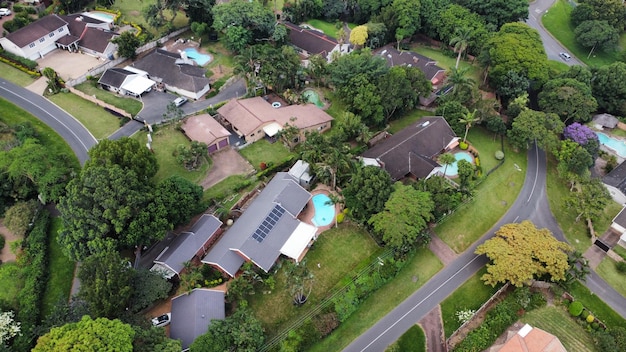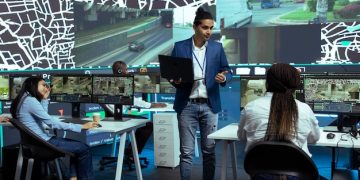Remote Work’s Suburban Shift: a 2025 Analysis

The Impact of Remote Work on Suburban Living: A 2025 Analysis reveals a significant shift in residential preferences, driven by increased remote work opportunities, leading to suburban revitalization and new challenges in infrastructure and community development across the US.
The dynamics of where we live and work are undergoing a dramatic transformation. A key driving force is the rise of remote work. Let’s look at The Impact of Remote Work on Suburban Living: A 2025 Analysis.
The rise of the remote workforce
The digital revolution has unshackled countless professionals from the traditional office setting. As technology continues to evolve at an unprecedented pace, the prevalence of remote work arrangements has surged, fundamentally altering the way Americans approach their careers and lifestyles.
This evolution is not merely a passing trend but is quickly solidifying as a permanent fixture in the modern work landscape. Statistics reveal a remarkable increase in the number of companies embracing telecommuting, flexible hours, and virtual teams. Cutting-edge communication tools and project management software enable workers to collaborate seamlessly regardless of their geographic location. This widespread adoption of remote work is driven by several factors, including:
- Cost Savings: Companies can reduce overhead expenses.
- Increased Productivity: Employees often experience fewer distractions at home.
- Access to Talent: Businesses can tap into a broader, more diverse talent pool.
In parallel with the explosion of remote work is the shifting demographic landscape of American society. Millennials and Gen Z, who grew up in technology-saturated environments, are now entering the workforce in significant numbers. These digital natives have a distinct preference for flexibility and work-life balance, further fueling the demand for remote opportunities. Moreover, the desire to escape the high costs and dense populations of urban centers is becoming increasingly appealing, especially to young families seeking more affordable housing options and safer environments for their children.

The suburban allure
As urban centers grapple with escalating living costs, cramped living spaces, and other challenges, US suburbs are experiencing an unparalleled revival. Suburbs, traditionally perceived as bedroom communities, are undergoing a renaissance, becoming vibrant, self-sufficient ecosystems that offer residents a blend of natural beauty, spacious homes, and a strong sense of community.
One of the primary drivers behind this suburban allure is the promise of a more affordable and spacious lifestyle. As remote work becomes more commonplace, the need to reside in close proximity to city centers diminishes, allowing families to explore housing options in suburban areas where they can obtain larger homes with yards at a lower price point.
The trend towards suburban living is evident across various age groups and demographics, from young professionals seeking a more tranquil environment to raise families to retirees opting for a slower pace of life.
Emergence of Suburban Hotspots
With this influx of new residents, many suburban communities are evolving into thriving hotspots that offer a plethora of amenities and opportunities. Here are a few trends:
- Revitalized downtown areas: Suburbs are investing in infrastructure development, bringing in new restaurants, boutiques, and entertainment venues.
- Enhanced connectivity: High-speed internet access and reliable public transportation options are making suburban areas more appealing to professionals.
- Community-oriented initiatives: Farmers’ markets, outdoor concerts, and local festivals are fostering a sense of belonging.
Challenges for suburban infrastructure
While the rise of remote work and suburban living presents numerous opportunities, it also introduces a set of challenges, particularly regarding suburban infrastructure. As more people relocate to suburban areas, existing infrastructure may struggle to keep up with the increased demand.
The expansion of suburban communities necessitates substantial investments in transportation networks, utilities, and public services. Aging roads and bridges may require urgent repairs or upgrades to accommodate the growing volume of traffic. Water and sewer systems must be expanded to serve the expanding population.
Smart infrastructure solutions
Fortunately, innovative solutions are emerging to address these infrastructure challenges. Some examples:
- Smart grids: Integrating smart technologies, like sensors and data analytics, help optimize energy distribution and prevent outages.
- Sustainable transportation: Investment in electric vehicle charging stations, bike-sharing programs, and public transit options help commuters reduce their carbon footprint.
- Water conservation technologies: Implementing smart irrigation systems, rainwater harvesting, and water-efficient appliances can alleviate water scarcity concerns.

Community and social dynamics
Remote work and suburban living are not just impacting physical infrastructure, they are also influencing community and social dynamics. As more people work from home, traditional social structures are evolving, leading to new forms of community engagement and interaction.
Telecommuting can lead to social isolation and a lack of face-to-face interactions. Recognizing this challenge, many suburban communities are actively promoting initiatives to foster a sense of belonging and connection through:
- Community centers: Act as hubs for social activities and events.
- Co-working spaces: Providing shared office environments for remote workers.
- Online platforms: Connecting neighbors, facilitate information sharing, and create virtual communities.
These strategies are crucial for nurturing strong social bonds and promoting civic participation in suburban neighborhoods. The ability to connect with others and engage in meaningful relationships contributes directly to residents’ overall health, happiness, and well-being.
Environmental impact
The widespread adoption of remote work and the shift towards suburban living also have significant implications for the environment. While telecommuting has the potential to reduce carbon emissions associated with commuting, expanding suburban development can contribute to urban sprawl, deforestation, and increased energy consumption.
Urban sprawl leads to longer commutes, increasing the dependency on private vehicles and resulting in more greenhouse gas emissions. Deforestation destroys natural habitats, disrupting ecosystems and reducing biodiversity. Larger homes in suburban areas amplify energy consumption for heating, cooling, and lighting.
Sustainable practices
Mitigating the impacts requires a multi-faceted approach that combines:
- Promoting compact development: Designing communities that encourage walkability, reduce reliance on cars, and preserve green spaces.
- Investing in renewable energy sources: Using solar panels, wind turbines, and geothermal systems can significantly offset the energy consumption of suburban homes.
- Encouraging sustainable transportation options: Promoting cycling, public transportation, and electric vehicles can reduce transportation emissions.
Policy and governance
Effectively managing the impact of remote work and suburban living requires thoughtful policy and governance frameworks. Local governments must collaborate with stakeholders, including developers, community organizations, and residents, to develop comprehensive land-use plans, zoning regulations, and infrastructure investment strategies.
Incentivizing sustainable development through tax breaks, grants, and density bonuses encourages developers to adopt LEED-certified building practices, promote mixed-use development, and incorporate green infrastructure.
Prioritizing infrastructure investments in water and sewer systems, transportation networks, and internet connectivity ensures that communities can support the increasing population.
Also, municipalities need to streamline permit processes and reduce bureaucratic hurdles to accelerate sustainable development projects.
By adopting a holistic approach to policy and governance, communities can effectively guide growth, protect natural resources, and foster vibrant, resilient suburban neighborhoods.
| Key Aspect | Brief Description |
|---|---|
| 🏡 Suburban Shift | Increased remote work drives more people to suburbs seeking affordable housing and bigger spaces. |
| 🌐 Infrastructure Demands | Suburbs face challenges in transportation, utilities, and connectivity due to growing populations. |
| 🌱 Environmental Impact | Urban sprawl and increased energy consumption raise environmental concerns; sustainable solutions are needed. |
| 🤝 Community Dynamics | Remote work can affect social interactions; community initiatives help foster connections and belonging. |
FAQ
▼
Remote work is driving more people to suburbs, seeking larger homes and more affordable living. This shift is revitalizing suburban communities with new amenities and opportunities.
▼
Suburbs face increasing demands on transportation, utilities, and internet connectivity. Aging roads and water systems require upgrades to support growing populations.
▼
Sprawling development can lead to more deforestation and higher energy consumption. Sustainable practices like renewable energy and compact development are essential for mitigation.
▼
Community centers, co-working spaces, and online platforms foster social connections in suburban neighborhoods. These initiatives combat isolation and promote residents’ well-being.
▼
Incentivizing sustainable practices through tax breaks and prioritizing infrastructure investments are beneficial. Streamlining permit processes can also accelerate sustainable projects.
Conclusion
The Impact of Remote Work on Suburban Living: A 2025 Analysis shows a transformative shift. As remote work becomes more entrenched, suburban areas are evolving but must confront infrastructure and environmental challenges. Thoughtful policies, sustainable practices, and community initiatives will be key to ensuring these areas thrive.





